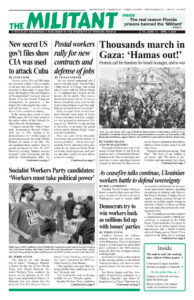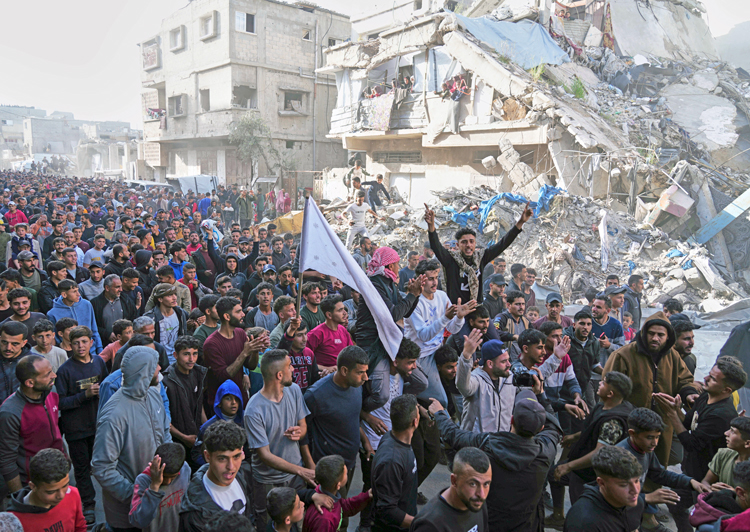Thousands of Palestinians took to the streets in Gaza March 25 and 26 to demand an end to Tehran-backed Hamas’ dictatorial rule. They are the largest protests there in years, signaling a renewed struggle by the toilers for their own interests. Gazans marched in Beit Lahiya, Jabaliya, Khan Younis, Gaza City and other towns.
Protesters carried signs saying, “Stop War,” “The blood of our children is not cheap,” and “We refuse to die.” Confident and determined, they chanted “Hamas out,” “Hamas terrorists,” “Out, out, out! Hamas get out!” and “We’re done with this war, we’re done with Hamas.” Unlike Hamas, protesters proudly showed their faces.
Months of Israeli blows have Hamas on the run, with its Nazi-like thugs hiding in tunnels and underground hideouts.
Contrary to the propaganda of Hamas apologists around the world that Israel’s actions are aimed at the Palestinian toilers, in fact its offensive is aimed at dismantling Hamas and defending Israel’s existence. The new protests against Hamas show developments are now opening up space for working people in Gaza to organize and remove the biggest obstacle they face: Hamas. Along that road prospects increase for working people in Gaza, Israel and throughout the region to join together to defend their common interests, combat Jew-hatred and national oppression and begin building a working-class leadership.
The protests will reverberate throughout the Middle East.
The bold actions in Gaza take place in the wake of a new Israeli offensive. Israeli forces launched multipronged attacks in northern, central and southern Gaza against Hamas, ending the two-month-long ceasefire in the face of Hamas’ refusal to free the remaining hostages, of whom 24 are still believed to be alive, and its moves to use the ceasefire to regroup and prepare further massacres against Jews in Israel.
The protests began a day after Islamic Jihad launched two or three rockets at Israel from Beit Lahiya and Beit Hanoun. Israeli authorities then ordered civilians to evacuate large parts of the towns.
‘Listen to the voices from the rubble’
For years Hamas has deliberately sacrificed Palestinian lives, by hiding its command centers and weapons in residential areas while launching assaults on Israel. Anger that this slaughter would resume with the end of the ceasefire motivated Palestinians to take to the streets of Beit Lahiya and Beit Hanoun, in northern Gaza. The protests spread rapidly, including to the south.
“We refuse to die for anyone, for any party’s agenda or the interests of foreign states,” Beit Lahiya resident Mohammed Diab told the press. “Hamas must step down and listen to the voice of the grieving, the voice that rises from beneath the rubble — it is the most truthful voice.”
Funding, training and arms from the reactionary bourgeois regime in Tehran were essential to Hamas carrying out its Oct. 7, 2023, anti-Jewish pogrom that massacred 1,200 people in Israel.
Some protesters called for Hamas to release the remaining hostages. “We want Hamas to resolve this situation, return the hostages and end this whole thing,” one protester told the press.
A message to the entire world
“We’re sending a message to the entire world: We reject the rule of Hamas,” another said.
Some protesters also denounced Qatar-based Al Jazeera for refusing to report on the opposition to Hamas. At a protest outside the Indonesian Hospital in northern Gaza, one participant noted that “the press entered the hospital so as to not document this event.”
Al Jazeera did not report on the protests until more than 10 hours after it hit other news channels, even though it had reporters on the spot. And then it brazenly lied about what happened, claiming the protests were against “Israeli genocide.” But Al Jazeera had to admit that “some” protesters chanted against Hamas over a video clip that showed hundreds chanting against them.
Then Al Jazeera noted that Israeli authorities sent text messages to Gazan residents supporting the protests and that “the solution is in your hands,” to try to give the false impression that Hamas opponents were acting on behalf of Israel.
Long-simmering opposition to Hamas is now being directly and publicly voiced. The Families and Clans of the Southern Governorates Gaza Strip issued a statement March 25 calling for broader protests.
“There is no longer room for silence or waiting for years of oppression, starvation and destruction,” they wrote. “In the name of the clans of Gaza, we call on you to a popular uprising against injustice and a march of anger that will shake the ground under the feet of those who sold our blood and exploited our suffering for their own narrow interests.”
“Hamas must lift its hand from Gaza immediately and end this unjust siege imposed on us because of decisions that do not represent us. … Gaza is not hostage to anyone,” the clans concluded. “Gaza will be liberated by the will of its people.”
A reactionary, Jew-hating group
The ceasefire in Gaza, which began Jan. 19, was inherently unstable because it left Hamas intact and armed. Hamas’ open aim — backed by Tehran — is the destruction of Israel and the Jews.
It cynically staged “ceremonies” handing over the hostages to claim that despite blows it suffered, it can’t be defeated, and to give the false impression that it is supported by the majority of Gazans. Many of the hostages were forced through small crowds under the “protection” of masked and armed Hamas thugs.
Hamas falsely poses as a liberation movement. After narrowly winning elections in Gaza in 2006, it crushed its political opponents in bloody fighting and has maintained dictatorial rule ever since. Hamas broke strikes by trade unions and restricted women’s rights. It diverted massive resources from cooperative United Nations and international aid agencies into building a vast network of tunnels from which it could attack Israel.
Hamas’ reactionary ideology, which it fosters in all of the schools in Gaza — funded by the United Nations Relief and Works Agency for Palestine Refugees — has direct roots in the Nazi Holocaust. Its Oct. 7 pogrom, planned over years with direct involvement of the reactionary regime in Iran, announced its intent to carry out Hitler’s “Final Solution.”
Threat of a nuclear Tehran
Meanwhile, President Donald Trump is stepping up his threats against Tehran as Washington pushes the regime there to agree to a new nuclear deal. After the U.S. military launched a series of airstrikes against Houthi militias in Yemen that have continued to threaten shipping in the Red Sea, Trump warned Tehran to “stop the sending of these supplies [to the Houthis] IMMEDIATELY.”

Trump says he has given the Iranian government a two-month deadline to reach a new nuclear agreement, or face an unspecified “other option.” During the course of a 2015 nuclear deal between Tehran, Washington and several European imperialist powers, the Iranian regime continued its march toward developing nuclear weapons that would be targeted at Israel. U.S. imperialism’s concern is to gain the most favorable circumstances for U.S. business in the region.
But the prospect of even a small Iranian nuclear arsenal poses a threat to Israel’s existence and to Jews, Arabs and all who live there. Netanyahu has made clear he won’t allow Tehran to get nuclear weapons.
Washington already maintains substantial financial and trade sanctions against Tehran, which come down hardest on the workers and farmers of Iran.
It’s working people in Iran who are the biggest obstacle to Tehran’s military adventures and drive to acquire nuclear weapons. There have been repeated mobilizations by workers, women, oppressed nationalities and others in Iran pressing their own fights against the regime. A frequent theme of many of these protests is opposition to Tehran’s “warmongering.”


